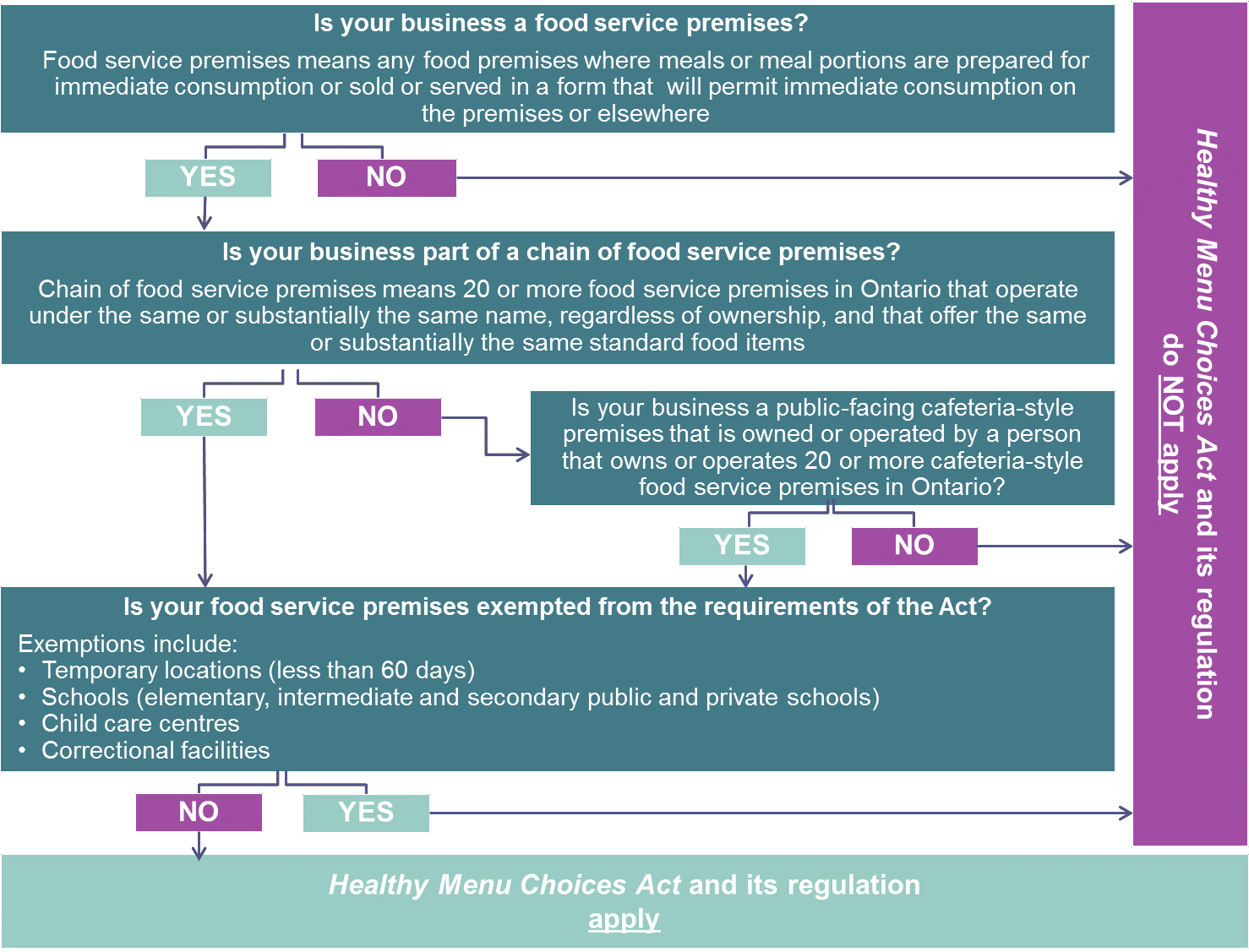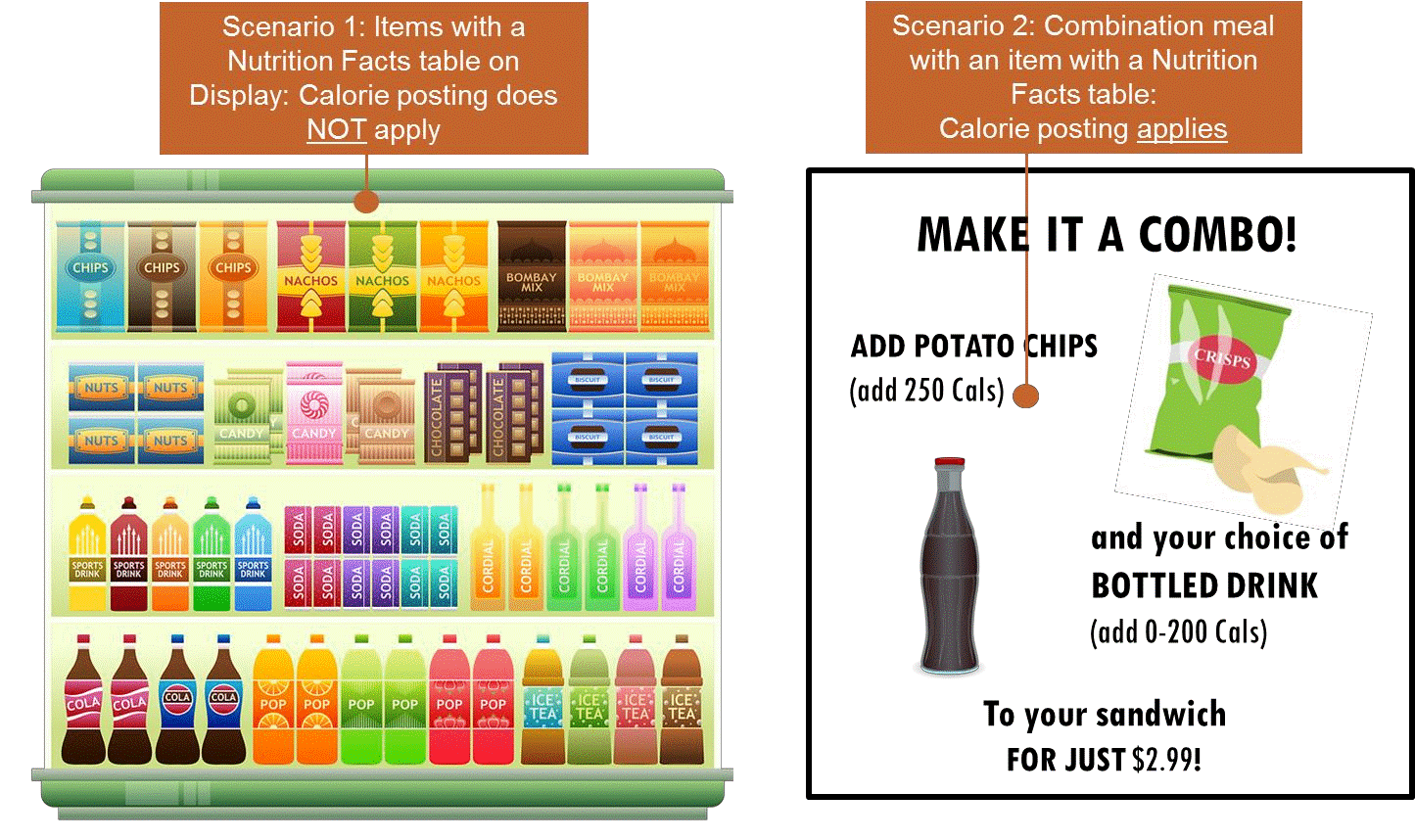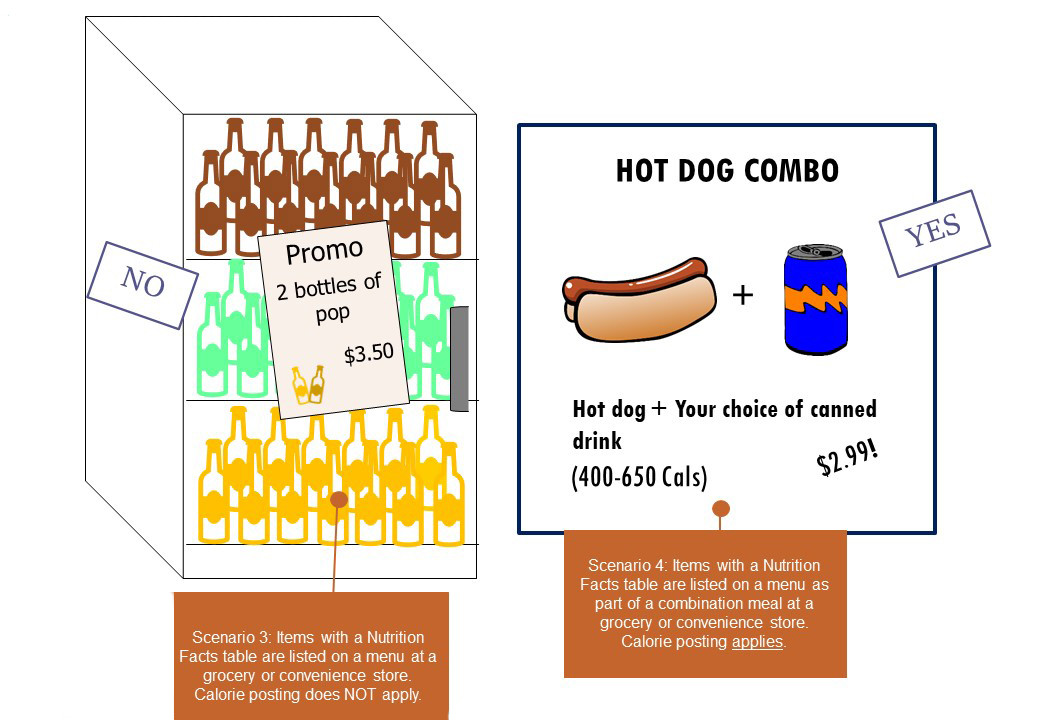Overview of the requirements of the legislation
What information must be displayed?
Food service premises with 20 or more locations in Ontario must display nutrition information as follows:
- The number of calories for every standard food and beverage item:
- on menus, and
- on display tags or labels, when the items are on display.
- A contextual statement, in English or in French.
footnote 1 As of January 1st, 2018 the following contextual statement must be displayed:
Adults and youth (ages 13 and older) need an average of 2,000 calories a day, and children (ages 4 to 12) need an average of 1,500 calories a day. However, individual needs vary.
When does the HMCA come into effect?
The Healthy Menu Choices Act, 2015 and its accompanying regulation came into effect on January 1st, 2017. Owners and operators of regulated food service premises have been required to comply with the menu labelling legislation as of this date.
How will the HMCA be enforced?
Minister-appointed inspectors in public health units have the power to enforce the HMCA. Please note that the ministry will train public health units on a progressive enforcement approach. This could include inspectors carrying out education visits, inspections, and responding to complaints regarding the posting of calories and signs in regulated food service premises. Progressive enforcement includes the use of more stringent charging options to reflect the frequency and severity of non-compliance.
Ministry designated inspectors are provided with training on enforcement expectations. Information provided to inspectors through the training process as well as implementation and enforcement materials are consistent with the information provided to industry.
Who must comply with these requirements?
An owner/operator can determine whether or not the HMCA applies to them by answering ‘yes’ or ‘no’ to the questions in the diagram below:

What types of food service premises must comply with the HMCA?
The types of food service premises with 20 or more locations in Ontario affected by the HMCA include, but are not limited to, chains of:
|
|
What types of food service premises are exempt from the HMCA?
The following types of food service premises are exempt from the HMCA:
- Food service premises that operate for less than 60 days in a calendar year (consecutively or non-consecutively).
- Food service premises located in a public or private school (i.e. elementary, intermediate and secondary).
- Food service premises located in a correctional facility.
- Food service premises that are located in a child care centre.
How does the regulation define Grocery Stores?
For the purposes of the HMCA, grocery stores are food service premises that sell a variety of canned, dry and frozen foods, fresh produce, bakery products, dairy products and household items. Convenience stores that offer for sale a variety of these items are also considered grocery stores for the purposes of the HMCA.
What food and beverage items are captured by the HMCA?
The HMCA requires calorie posting for restaurant-type standard food items in regulated food service premises. Items that require calorie posting are food or drink items that:
- are served or processed and prepared primarily at the premises;
- are intended for immediate consumption;
- do not require further preparation by a consumer before consumption (i.e. foods that are generally considered to be ‘ready to eat’); and
- are sold or offered for sale in servings that are standardized for portion and content.
A food service premises owner or operator can determine whether or not the HMCA applies to their food or drink items by answering ‘yes’ or ‘no’ to the questions in the diagram below:

The regulation also clarifies specific items that, when sold at grocery stores and convenience stores, are not subject to menu labelling requirements because they are not considered standard food items.
What food and beverage items are exempt from the menu labelling legislation?
The following food and beverage items are exempt from the menu labelling legislation:
- Menu items offered for less than 90 days in a calendar year.
- Self-serve condiments that are free of charge and not listed on the menu.
- Patient meals in hospitals, long-term care homes, psychiatric facilities and retirement homes.
- Special-order items.
- Items in a vending machine.
- Unprepared fruits and vegetables that are sold by weight or unit.
- Items exempt from having a Nutrition Facts table (NFt).
Further details on each exemption, including examples of what is captured and not captured, are provided below.
Temporary or limited time offer menu items
- Food or beverage items that are offered for sale for less than a total of 90 days (consecutive or non-consecutive) per calendar year are exempt from menu labelling requirements.
- Note that this exemption refers to whether the item is sold or offered for sale temporarily but does not refer to a situation where there is a temporary/ promotional offer whereby only the price of the item changes.
- Examples of items not captured by the HMCA:
- A rotational item that is offered for sale once a week (52 days of the year).
- A seasonal item that is offered for sale for 60 days.
- A market test item that is offered for sale for one month (30 days).
- A combination meal with a seasonal or market test item that is offered as a component of the meal for less than 90 days in a calendar year.
- If only one option in the combination meal referred to immediately above (e.g. pop with burger) is a market test or seasonal item (e.g. market test pop); the other combination meal options (e.g. other flavours of pop that are regularly sold) are captured by the requirements of the HMCA.
- Examples of items captured by the HMCA:
- A rotational item that is offered for sale every 3 days (121 days of the year).
- A seasonal item that is offered for sale for an entire season (120 days).
- A market test item that is offered for sale for 3 months (90 days).
- A standard food item that is sold year-round but it is offered temporarily within a promotion (e.g. under a promotional price) or in a temporary combination (e.g. pairing with another standard food item under a combo meal).
Self-serve condiments
- Condiments placed on a table, counter or elsewhere for general use without charge and not listed on a menu are exempt from menu labelling requirements.
- Examples of items not captured by the HMCA:
- Complimentary condiments available on the table or counter for general use, such as ketchup, mustard, mayonnaise, salt, pepper, hot sauce, and vinegar.
- Complimentary self-serve sugar, sweetener, milk, cream offered for general use by customers for their hot beverages.
- Examples of items captured by the HMCA:
- Condiments that are a part of a standard food item, such as a burger that comes standard with ketchup and mustard, dipping sauces that come standard with a chicken wings order, or a salad that comes standard with dressing. The condiments would be included as part of the total calories for the standard food item.
- Condiments that are listed on a menu or display label or tag as part of a variable/customizable standard food item, such as when a customer chooses what type of sauce they want on a customizable sandwich.
Patient meals in hospitals, long-term care homes, psychiatric facilities and retirement homes
- Meals served to patients in hospitals and psychiatric facilities, or residents of long-term care homes and retirement homes are exempt from the HMCA.
- However, public-facing cafeterias in hospitals, long-term care homes, psychiatric facilities and retirement homes are captured by the HMCA if they are owned or operated by a person who owns or operates 20 or more cafeteria-style food service premises in Ontario.
Special-order items
- Food or beverage orders that are prepared in a specific manner based on an individual customer’s request, which requires the regulated food service premises to deviate from its usual preparation of the standard food item are exempt from menu labelling provisions.
- However, regulated food service premises that offer standard food items that are meant to be personalized are not exempt from posting calories for those items.
- Examples of items not captured by the HMCA:
- Removal of an item from a standard food or beverage item, such as a customer requesting no onions on a burger which usually comes with onions.
- Addition of an item which is not listed on the menu, such as a customer requesting hot sauce on a standard sandwich that does not come with hot sauce.
- An alcoholic beverage that is custom-ordered by a customer.
- Examples of items captured by the HMCA:
- Toppings for a standard food item that are on display or listed on a menu, such as cheese to be added to a burger or onions that are on display for customers to create their own sandwich.
- Types of bread that are listed on the menu or that are on display and a customer can choose to customize their sandwich or hamburger.
Standard Food Items in a Vending Machine
- Standard food items in a regulated food service premises that are in a vending machine are exempt from the requirements of the HMCA.
- Examples of items not captured by the HMCA, provided they are not listed on a menu:
- A sandwich sold through a vending machine.
- A can of pop sold through a vending machine.
- Examples of items captured by the HMCA:
- Beverages sold through a self-serve dispenser.
- A can of pop when it is listed on a menu at a quick service restaurant that is a regulated food service premise.
Unprepared Fruits and vegetables
- Unprepared whole fruits and vegetables that are normally sold by weight or unit and that are not part of another standard food item.
- Examples of items not captured by the HMCA:
- A whole banana sold individually.
- A box of cherry tomatoes.
- Examples of items captured by the HMCA:
- A banana sold as part of a breakfast combination meal with a coffee and a muffin.
- Melon that is peeled, cut, and sold in a salad bar for immediate consumption.
- Cherry tomatoes that are part of a salad.
Items exempt from having a NFT
- Standard food items that are prepackaged, as defined in the Food and Drug Regulations made under the Food and Drugs Act (Canada), and that are exempt from the Nutrition Facts table requirements of those regulations.
What food items are exempt from calorie posting on a menu, label or tag if sold in a grocery or convenience store?
The following items, when sold at a regulated grocery or convenience store, are not considered standard food items, and thus are exempt from the calorie posting requirements:
- Deli meats and cheeses that are normally sold by weight and that are not part of another standard food item;
- Prepared fruit and vegetables intended for multiple persons;
- Bread, buns and rolls that are not part of another standard food item;
- Olives and antipasti that are not part of another standard food item;
- Food or drink items sold outside of the food service section of a grocery store; and
- Standard food items with a Nutrition Facts table (NFt) that meets the requirements of the Food and Drug Regulations made under the Food and Drugs Act (Canada) and that are not part of another standard food item.
Note that if any of these items are part of a standard food item (or part of a combination meal) they would require calorie posting.
- Examples of items in a grocery store/convenience store not captured by the HMCA:
- Deli turkey meat that is portioned for the customer to be sold by weight, and that is not being sold as part of another standard food item (i.e. not part of a sandwich).
- A party sized fruit tray intended for multiple persons.
- A bagel that is sold in the bakery and is not part of another standard food item (i.e. not part of a sandwich).
- Olives that a customer serves for themselves and are not part of another standard food item (i.e. not part of a salad or combination meal).
- A can of pop that has an NFt and is sold individually and that is advertised in a sign posted at the cooler of a convenience store.
- Examples of items in a grocery store/convenience store that may be captured by the HMCA:
- A club sandwich with deli cheese that is a standard food item and prepared at the grocery store.
- Cut melon in a salad bar that is intended for immediate consumption.
- A bun that is offered for sale in a combination meal with the purchase of a soup.
- Olives that are offered within the self-serve salad bar for a customer to include in their salad that is intended for immediate consumption.
- A can of pop that has an NFt and is sold with a combo meal, and the combo meal is advertised in a sign at the convenience store.
Food or drink items sold outside of the food service section of a grocery store.
- “food service section” means a section in a grocery store where the food and drink items that are sold or offered for sale, including at a food counter, whether the counter is clerk-served or self-serve, are primarily restaurant-type food and drink items that are not the subject of an exemption under this Regulation.
- Examples of items in a grocery store not captured by the HMCA:
- A tray of cheese that is sold in the deli section of a grocery store.
- Tuna salad sold in the fish counter of a grocery store.
- A bun sold in bulk in the bakery section of a grocery store.
- Examples of items in a grocery store captured by the HMCA:
- An individual tray of cheese that is sold in the “Ready to Eat” food service section of a grocery store.
- A tuna sandwich prepared at the sandwich bar of a grocery store.
- A muffin that is sold in the café section of a grocery store and is intended for immediate consumption.
What standard food items that are on display are exempt from posting calories on a label or tag?
The following food and beverage items are exempt from posting calories on a label or tag:
- Items with a Nutrition Facts table that are on display, but not listed on a menu;
- Alcohol beverages on display, but not listed on a menu.
Further details on each exemption, including examples of what is captured and not captured, are provided below.
Items with a Nutrition Facts table (NFT)
- Items that are on display with a NFT that meets the requirements of the Food and Drug Regulations made under the Food and Drugs Act (Canada) are exempt from the requirements of the HMCA.
- However, if the item with an NFT is listed on a menu, its calories must be displayed on the menu. Note that this requirement to post calories for NFT items listed on a menu and that are not part of another standard food item does not apply to grocery or convenience stores. Also, if the item with an NFT is part of a combination meal, the calories for the item with the NFT must be included in the calories displayed for the combination meal, both in grocery and convenience stores and all other types of regulated food service premises.
Example #1: Displaying calories for pre-packaged foods with a Nutrition Facts table in regulated food service premises that are not grocery or convenience stores

Example #2: Displaying calories for pre-packaged foods with a Nutrition Facts table in regulated food service premises that are grocery or convenience stores

Alcohol beverages on display
- Alcohol beverages on display that are not listed on the menu (e.g. back bar) are exempt from the requirements of the HMCA.
- However, if the alcohol beverage is listed on a menu, calories must be posted on the menu. In addition, if the alcohol beverage is part of a combination meal, the calories for the item must be included in the calories displayed for the combination meal. See section 3.10 for details.
- Examples of items not captured by the legislation provided they are not listed on a menu:
- Spirit bottles on display behind the bar.
- A bottle of beer or wine on display on the back bar or open cellar.
- Examples of items captured by the legislation:
- Standardized alcoholic beverages that are listed on a menu.
- A cocktail advertised on a table topper that lists the price.
Footnotes
- footnote[1] Back to paragraph For the French contextual statement, please refer to the French version of the regulation, or the French version of this guide